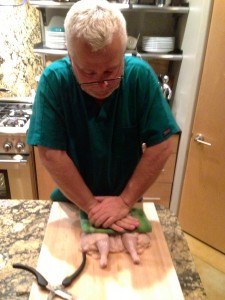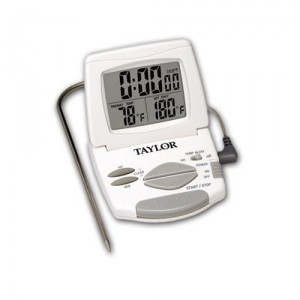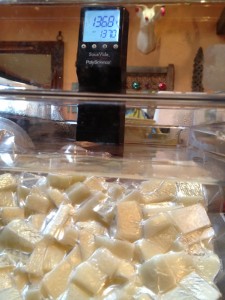Food Poisoning: Don’t Get Mis-Diagnosed

In the kitchen and in the Operating Room
You wake up feeling like you are hung-over, muscles hurt, then you realize you need to run to the bathroom. You call in sick to work, and spend the day in bed – quietly hoping your intestines will calm down and while you don’t feel like eating – you just want to keep down some water for a bit. The next day you wake up feeling fine- maybe a touch weak, but ok. It isn’t the flu, you were poisoned.
No virus, influenza or otherwise, lasts for only 24 hours. When flu season comes, that miserable virus will last 2 to 3 weeks. What does last for that period of time is food born illness. So before we go into that– be sure to get vaccinated against the flu!
Kitchen Safety and Avoiding Food Poisoning
Food poisoning (technically we doctors call it foodborne illness) happens when we eat or drink something that is contaminated with bacteria, parasites, or viruses, or with some chemical that causes illness.
FACT: Every year 48 million people in the United States become ill from food, 128,00 are hospitalized, and 3,000 people die from foodborne illnesses.
With chicken we worry about salmonella.However, if you are cooking above 130°F, the salmonella bacteria are unable to grow, as are all other common bugs. Still, food safety is important. Wash hands after handling raw meat, and wash all surfaces and utensils after they come in contact with raw meat. It is more likely that the raw meat will contaminate those surfaces and that those surfaces will pass the bugs onto other foods than you becoming sick from the meat directly.
For beef, the FDA states that it is safe when kept at a temperature of 130°F for 112 minutes or 140°F for 12 minutes. The temperature of a rare steak is between 130°F and 139°F in the center. By cooking the steak for 45 minutes at 136°F in a sous vide water oven, you will keep well within the recommended limits. Some cook the steak longer—two to four hours—but I find that 45 minutes for a 1-inch-thick steak works well. The fast grilling of a steak or standard cooking will also kill those bacteria.
Cross-Contamination

Proper handling of poultry – includes washing all surfaces and utensils
The biggest issue with bacteria and food safety is cross-contamination. This means the bugs from one food are passively transferred to another food, where they grow. For example, if you wash some raw chicken in the sink where there is a cutting knife, you can contaminate that knife with bacteria. If you clean the knife insufficiently to rid it of the bacteria and then use it to cut some cooked eggs, these eggs can become the perfect place for bacteria to grow like crazy (especially if the eggs sit at room temperature). If you eat the eggs, you can get sick from the chicken (so the chicken came first). The lesson here is that if you wash raw poultry in the sink, be sure to have that sink cleaned out well to avoid cross-contaminating other utensils or serving dishes. Anytime you handle any raw meat or eggs, treat everything they touch as if it just came out of the toilet.
Do not use the same cutting board for raw and cooked meats. If you own only one cutting board, be sure to wipe it down with a bleach solution after cutting raw meat on it.
If you use a knife or fork or any instrument on raw meat, wash that utensil carefully. Essentially, consider raw meat to be contaminated, along with anything it touches: you, your clothes, your cooking utensils, your cutting boards, and your knives. Remember, when people get sick from the bacteria from raw meat, it is typically because of cross-contamination from other foods, from food workers improper techniques.
Refrigerate all foods promptly. If food is at room temperature for more than two hours, it may not be safe to eat. The bacteria that cause food poisoning typically do not produce an odor or change the texture of the food. Think about this the next time someone invites you to a buffet.
Make certain that your refrigerator is kept at 40°F or cooler, and that there is plenty of room for air to circulate in the refrigerator. Keep the freezer at or below 0°F.
Wash your hands carefully. I use a special soap made primarily from alcohol, the same type of soap surgeons use before scrubbing in the operating room. You can purchase this from most stores; one brand is Purell. Always wash after handling raw meat, poultry, fish, shellfish, produce, or raw eggs. Scrub and lather for at least for 20 seconds after handling any raw meat. An easy way to do that is to sing “Happy Birthday” to yourself twice while scrubbing your hands.
Wash all fruits and vegetables under running water before eating or cooking them. Use a vegetable brush to scrub melons and cucumbers, and then dry with a paper towel. Consider the vegetable brush contaminated, so sanitize it frequently.
It is better to throw out food than to be sick. Don’t be afraid to toss out any food that makes you suspicious.
How do “they” decide how much and how long to cook? Microbiologists have determined how much heat and time is needed to kill 90 percent of the bugs To kill 99 percent of the bugs you have to cook the food for twice as long (or increase the heat).
MYTH: You want to kill all those bugs!

Using a digital thermometer means never guessing
No, let’s not. First, it is probably impossible to do that. Second, the longer you cook something or the higher temperature you cook it, the more the heat will affect the flavor of the food. There are no guarantees that overcooking food will make it safe, or that under cooking food puts you in danger.
Because it is an average, the standards are much higher than commonly needed. Even if you were to kill 99.9999 % and someone’s thermometer was off, or the oven was not heating properly, then overcooking provides some safety but at the expense of flavor.
The entity responsible for this in the U.S. Department of Agriculture (USDA) is the Food Safety and Inspection Service (FSIS). As with most government bodies, it has a scientific advisory panel that makes recommendations. The advisory panel found that the FSIS figures for poultry were way too high. The FSIS recommends temperature and time enough to kill 99.99999 percent of the bacteria) but the panel recommended enough to kill 99.995 percent of the bacteria. At 122°F there are no bugs that are known to survive – on this planet.
“But on Chopped they reject under cooked food!”
I’m a huge fan of the Food Network. On the show Chopped you will see the judges reject food that they consider “under cooked” or “raw.” Are they crazy? Well, they might be (most chefs, like surgeons, get a bit nutty). But they sometimes are overdoing it when it comes to chicken or worrying about cross-contamination in a 20- to 30-minute contest. The funny thing is they will eat something that a chef has double-dipped. (The mouth has a far higher bacteria content, but if they would kiss it, they eat it!) The bottom line: over cooking foods ruins the flavor and texture. Pork can be pink, and chicken should not be cooked to an internal temperature of over 145 – and use a thermometer (guessing is never precise).
My favorite quote is from Chef Gordon Ramsay, who on his show “Hell’s Kitchen” will scream at the contestants when they under cook food (they usually under cook scallops or halibut on the stove top). He yells: “It’s raaaaaw!!!” Then tosses the food on the floor or in the trash.

It’s RAAAAW
REFERENCES:
(1) The loss from food borne illness in the United States is about 77 billion dollars a year.
J Food Prot 2012 Pub Med ID 22221364
(2) The time and temperature combinations for beef can be found from the Food Safety and Inspection Service guidelines. http://www.fsis.usda.gov/oa/fr/95033f-a.htm The part of their Chart is here: Min Internal Temp F 6.5 log lethality 7.0 log lethality 130 F 112 min 121 min 135 F 36 min 37 min 140 F 12 min 12 min 145 F 4 min 4 min 150 F 67 seconds 72 seconds The 6.5 log lethality means you are killing 99.99997 percent of the bugs (also called 6.5D) . A 7D lethality means you are killing 99.9999999 per cent of the bugs. If you have highly contaminated poultry (37,500 bacteria per gram of raw meat) then 3.5 ounces of meat would have 5.4 million Salmonella. To drop 7D means you would reduce 10 million pathogens to one bug. It takes about 105 Salmonella per gram of food to cause illness, less Salmonella than that cause no clinical symptoms. Thus, with worst case scenario you could kill just 99.999 per cent of the bacteria and not have symptoms (a 5D reduction).
| Min Internal Temp F | 6.5 log lethality | 7.0 log lethality |
| 130 F | 112 min | 121 min |
| 135 F | 36 min | 37 min |
| 140 F | 12 min | 12 min |
| 145 F | 4 min | 4 min |
| 150 F | 67 seconds | 72 seconds |
The bacteria E. coli strain 0157 can cause illness with as little as 10 bacteria per gram of food. Thus a 6.5 D would not be adequate but a 7D would. As you increase the temperature, it decreases the time – it is a logarithm scale, which is why the drop in time with an increase in temperature. In low temperature cooking (Sous Vide), medium rare beef is typically cooked at 136 degrees for 45 minutes to an hour. That, combined with the searing of the surface at 400 degrees (most bacteria would reside on the surface of the meat) in addition to seasoning the surface of the meat with salt,which also kills bacteria, provides a large margin of safety. Most bacteria do not live above 120 degrees, and as you increase the temperature you kill more of them. At 102 degrees most bacteria can no longer reproduce- which is the protective nature of human fevers.

Sous Vide – its quite safe
(3) There are many ways of becoming contaminated by food workers. Most food illness comes from food workers, not from cooking. Another reason to cook and eat at home.
J Food Prot 2009 Pub Med ID 19205488
(4) Hand washing guidelines can be found at the CDC website. The keys are to not wear rings, jewelry, watches when handling raw food. Soap and water are fine- keeping the water running or turning on the water with a paper towel works. After any food preparation, and as often as needed, to remove contaminated residue. Remember, before handling food to wash also- consider your hands unclean. http://www.cdc.gov/nceh/vsp/cruiselines/handwashing_guidelines.htm
I like to hand wash by singing “Happy Birthday” twice – then I know I am done!
Parts of this post come from our new book coming out soon — (we hope) – called JUST EAT.
